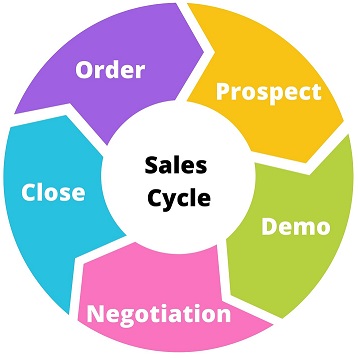Giving a perfect sales demo always helps you close deals quickly and shorten your sales cycle. But often many Entrepreneurs and Sales teams struggle to give a perfect sales demo to seal the deal.
In this post, we shall explore some handy tips to help you give a perfect sales demo every single time.
 |
| Photo by MART PRODUCTION from Pexels |
1. Research about the prospect
Sales demo is yet another form of a meeting. To make best use of the meeting, you should do your homework right. Before the meeting, try to spend some time researching your prospect and understand the context. Try to learn more about the company where the prospect works, the industry in which they work, the types of customers they have, their business, their long term and short term goals, their pain points and how your solution is going to help them.
2. Inform the agenda of the demo beforehand
While scheduling a demo, always ensure to inform the agenda and give a brief outline of what you plan to cover during the course of the meeting. Having a pre-planned agenda helps you to avoid any surprise questions during the course of the demo and the prospect would have come prepared.
Some demos tend to be detailed while some tend to be very short depending upon the solution you are trying to sell. When prospects are aware of the expectations, they are well prepared to focus longer or shorter as per the plan.
In addition to that, this also gives an opportunity to the prospect to suggest any additional topic in advance, which they would like you to cover during the demo.
3. Before starting the demo, establish trust/rapport:
Before you start the demo session, spend a few moments to warm up your prospects. You can ask about what's happening, try to make them feel comfortable with you. This helps to bring a sense of connection and helps to establish trust and rapport. This way they would be attentive and interested during the course of the demo.
4. Personalize the demo
Instead of trying to give a plain and generic demo about the product, try to personalize the demo based on their expectations and pain points. You would be already familiar with their pain points based on your previous discovery call or lead qualification call. If you are unaware, then you can also take some inputs from the customers on their pain points during the course of the demo and try to personalize the presentation.
5. Focus on Solution selling than Feature selling
Remember that prospects are more interested to know how your product will help you solve their pain points rather than knowing the nitty-gritty of each and every small feature of your product. Try to sell solutions instead of doing a feature list dump during the presentation.
6. Pause regularly and seek questions/feedback during the demo
A good demo is the one that helps to keep the prospect engaged. Prospects are well engaged if you involve them in a two-way conversation instead of doing a one-way presentation. During the course of your demo, you can pause at regular intervals and prompt them to ask any questions or give feedback during the demo. Making them talk keeps them interested throughout.
7. Note down any specific query to be addressed later
When you are selling a solution, you are bound to get certain queries that you may need to explore further to answer them better. Instead of blabbering any wrong facts to the prospect, you may make notes of the queries in your meeting notes or in a CRM like ToolsonCloud to come back on it later.
I hope you will find these tips useful.
If you are looking for a Sales CRM to manage your sales process, Feel free to check out ToolsonCloud Sales CRM. You can also schedule your sales demo meetings directly from your CRM application.
 |
| Photo by Lukas from Pexels |
It takes skills to find leads, but it requires more effort to convert these leads into sales. Based on the research conducted by Verse, marketing and sales teams leave about 55% of leads neglected. This shows how the majority of leads don’t convert into sales are put to waste, but you can take measures to reduce lost leads and produce better conversion rates.
Leads are vital if you want your company to succeed and different teams from your organization should work together. Read more on how to convert leads into customers.
1. Assess Your Organization
Identify the pain points in your company to improve your lead generation and conversion process. You may look into the following factors during the assessment:
- Company size - How you will approach conversion depends on your manpower
- Channel - Look at the existing channels which will reveal which is the least profitable and most effective channel
- Demographics - Understand the demographics of the market conditions, your target leads, and local competitors
- Industry - Taking a look at the general picture of your industry will also help to stay updated on trends in the targeted leads
- Conversion cycle stage - By analyzing the exact points where leads’ interest go downhill, you’ll be able to adjust your conversion process.
2. Stay in Touch with Your Audience
Buyers and consumers are more skeptical of the rampant push-for-sales and advertising they see online. Hence, you must maintain constant communication with them. Instead of spending the majority of your time researching leads, scheduling calls, and planning emails, allot time to actually talk to your existing prospects. Doing this will take you out of the loop of simply generating and capturing leads and contacts without converting them into sales.
Lead conversion software can help you keep in touch with your audience as you no longer have to manually manage your leads. ToolsonCloud is one CRM application that can help you organize your leads. Its email integration feature sends emails to contacts directly from the application. In addition, it is cloud-based which stores all information online. With this feature, you and your team can organize personal contacts for your leads.
Part of keeping in touch with your audience is determining unresponsive leads. You may do this through quick follow-up emails or phone calls asking your leads if they are interested in purchasing the service or product. This is an effective way to weed out dead leads and to quickly convert leads into sales before a lot of time passes.
3. Focus On Monitoring
After identifying your dead and active leads, you already have an idea on what specific leads to invest your energy and time into. It’s best to know what stage your leads are at the moment. Better visibility on the active leads will give you insights on the next steps to take.
From the moment that the leads are generated, make it a habit to record the leads. As you do this by using CRM software, you’ll be able to monitor the leads better throughout the sales funnel.
Furthermore, CRM helps with this tracking process. If you can find one that provides reports and insights, then that would provide data-based decisions for your organization. ToolsonCloud has very useful tracking features like adding activity and setting reminders for follow-up tasks, insights reports, and sales pipeline manager.
4. Collaborate with Your Team
You must communicate goals to your team. Goals are set by the upper management, but it's the entire company that will have to implement them. There are many ways to communicate goals. You can do it via a formal document, face-to-face or virtual meetings, or through a software that allows collaborative features. Whatever way you choose, it’s important that you define your goals, craft a strategy, stick to it, and implement it.
The best lead management software allows social collaboration. ToolsonCloud provides you with the freedom to collaborate within sales teams with its options to assign leads, deals, or tasks. You may also measure the performance of your employees with ToolsonCloud which promotes accountability.
Path Towards Sales
It can be overwhelming to figure out how to convert customers into sales. However, you can take on the above-mentioned actionable steps.
Your journey towards converting leads to sales may also be aided by different platforms and software. You may build organic leads using social media or manage active leads using a CRM software.
You can take your pick for the platform and software that you are going to use. If you are looking for a CRM software with a clean and lightweight user interface, then try ToolsonCloud by signing up here for free.
This is one of the commonly asked questions from sales professionals as well as entrepreneurs who are getting into sales for their startup.
Let us explore more about the Sales process and the need for it in detail
What is a Sales Process?
Sales process refers to the well-defined steps for sales comprising various sales activities which helps in closing the deal thus leading to final conversion. The process of every organization may differ depending upon the industry in which they operate and the complexity of the business. However, there are certain common steps that are part of the sales process which are used as a reference. These are:
- Prospecting for Qualified Leads
- Pitching them the solution to generate interest
- Based on their interest, having further discussions with a detailed presentation, demo, etc.
- Negotiation on contract, pricing, and terms & conditions.
- Deal Closure
- Order, Invoicing, Payment follow-up, etc.
 |
| Sales Cycle |
Using these steps as a reference, a Sales Manager or an Entrepreneur can easily build their sales process as per the context of their organization structure and process.
Well before we proceed, if you are planning to make use of CRM software to help organize your sales process, feel free to check out ToolsonCloud Sales CRM.
Why do you need a well-defined Sales Process?
More often we may find a defined sales process is only present in large organizations and not followed religiously in small businesses or startups. When the startups start scaling up, they realize their sales process is too complex to scale fast. This is where they start looking towards building an effective sales process.
Here are some of the reasons why you may need a well-defined sales process…
1. Scalability
When you have defined steps to follow as part of your sales process, it becomes a framework or a blueprint for your team to follow. Your team can just follow the blueprint and easily close the deal faster compared to when each of the sales representatives tries to follow their own approach which might work or might not.
2. Easy to Learn, Train, Mentor
Having a clear process that is followed across the team helps your team to easily learn that and they are equipped to easily train your new joiners to onboard them faster. Otherwise, if there is no process, whenever you assign a mentor to the new joiner, the takeaways will always be different for each new joiner and may lead to misalignment.
3. Low Customer Acquisition Cost
When you have a well-defined process, teams tend to spend less time recreating already validated experiments and focus on what works. This allows them to close more deals in a lesser amount of time which automatically brings down your sales operation cost. Lower the sales operation cost, lower becomes your customer acquisition cost. This way, you will be ready to close more deals with the same amount of sales budget.
4. Better Brand Image and Customer Loyalty
Customers often love organizations that follow a well-structured approach to whatever they do. This also includes how they sell and onboard the customers. If the sales process is streamlined and smooth, the customers will also be able to sense it based on the different sales touchpoints they experienced and how fast they were onboarded. Having a good onboarding experience always helps build a better brand image and customer loyalty. Loyal customers often become evangelists and they refer more customers to you.
I hope you liked reading this post. A good CRM tool always helps the sales team to work on a pre-planned and streamlined sales process. This also helps the sales manager keep track of the state of any particular lead so that they can pitch in to help out the team at the right moment.
If you are yet to try out a CRM tool for your team, feel free to check out ToolsonCloud Sales CRM. ToolonCloud CRM allows you to create your own sales process with the help of customizable deal pipelines and stages.
Since the start of the Covid19 pandemic, a majority of workers have moved to remote work. This has equally impacted sales teams in both positive as well as negative ways. On one side, the workforce is able to save more time for families which was earlier spent on travel. At the same time, organizations feel they miss the benefits of working with a co-located team such as more collaboration, more knowledge sharing, healthy competition as well as team relationships.
Moreover, sales teams tend to be more impacted with this since a majority of sales used to be face-to-face sales and while working with co-workers, they used to get trained on various sales techniques while watching their peers do the same.
Like it or not, Industry analysts predict that remote work culture is here to stay for longer than we would have imagined. In this post, let us explore the ways you can manage your remote sales teams better.
 |
| Remote workers |
1. Well Defined Sales Process
When the sales teams are co-located, teams can easily align themselves with the process their peers follow for sales. But when it comes to remote teams, salespeople rarely get to watch their peers throughout the day to learn the best practices. As a sales manager, the best you can do is to define a well structured sales process for your team so that team can follow them as a guidebook. This way you can avoid unnecessary experimentations by every team member to reinvent the same wheel.
2. Make SMART goals specific to remote selling context
Remote selling differs from the way sales happen in co-located teams or face to face selling. So you may be required to redefine your sales goals for remote sales context by assessing your past sales data. Try to make SMART (Specific, Measurable, Achievable, Relevant and Time-bound) goals for your team as per the remote sales context. This will ensure the team can quickly align themselves on the same.
3. Make team aware of goals and commitments
Remote teams get very less chance to meet the sales leaders of the organization. This may bring in the risk of working in silos where the team is not having a clear and common understanding of the organizational goals and commitments. It is the duty of the sales leaders to constantly communicate their business objectives, short term and long term goals. Keeping everyone on the same page and reinforcing it with constant communication helps everyone aligned to common goals and timelines.
4. Invest in remote tools for effective sales and team collaboration
While working remotely, a team may require a set of tools which can help them collaborate in real time as well as engage in remote sales. Some of the tools may include online messenger for your organization, VoIP telephony, video meeting tools like Zoom, Google Meet, etc.
In addition to these, the sales team shall require a CRM software so that the team can collaborate together on multiple leads, deals, sales tasks, etc. If you are yet to adopt a CRM software for your business, feel free to check out our cloud based CRM software which is built for startups and small businesses.
5. Monitor sales reports & metrics
In order to gauge the performance of your team, it is necessary to regularly track your sales reports and metrics. This helps you step in at the right time and help out your team members exactly at the time when they need some help closing a deal.
You can track the same via an excel sheet or if you have a notable team size, it is recommended to use a cloud CRM which can generate real time reports for you without you having to manually extract data, clean it up and create dashboards in excel sheets over and over again.
6. Organize remote social gatherings for team building and connect
The real missing element in remote teams is the social connect and the relationship which they have with their peers. Organizing online social gatherings periodically helps build the connection and relationship among the co-workers. Nobody likes to be working in a factory around machines. They like it when they find humans with whom they connect, share and learn from them.
7. Take every opportunity to celebrate, appreciate and motivate
To keep up the momentum, you should make use of every opportunity to celebrate small milestones, appreciate the performers to drive innovation as well as motivate your team to keep up the same momentum. Sales is largely motivation driven. Do every bit to keep the team’s motivation level high.
8. Train, Give feedback and Mentor
During the course, many new members shall join the team who may be new to your way of working. Support them with good training, give constant feedback and mentor them towards success. This way you shall build a successful team work culture for long term growth and success.
By the way if you are yet to try our CRM software, feel free to try out
ToolsonCloud Sales CRM, It’s Free.


